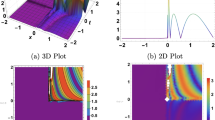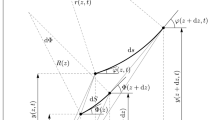Abstract
This paper focuses on the construction of analytical approximate solutions for an asymmetric conservative single-degree-of-freedom oscillator. First, based on the asymmetric oscillator, two symmetric ones are introduced; then, the second-order Newton iteration method and the harmonic balance method are applied to the two oscillators, respectively; finally, the analytical approximate solutions of the asymmetric oscillator are constructed and expressed by the oscillation amplitudes. Each iterative step needs the Fourier series representations of the restoring force functions and their first and second derivatives, of the two symmetric oscillators. Using only one iterative step can obtain accurate analytical approximate solution valid for a large range of oscillation amplitudes. Two examples are presented to illustrate use and high accuracy of the proposed approach.







Similar content being viewed by others
References
Nayfeh, A.H., Mook, D.T.: Nonlinear Oscillations. Wiley, New York (1979)
Hagedorn, P.: Nonlinear Oscillations. Clarendon, Oxford (1988)
Mickens, R.E.: Oscillations in Planar Dynamic Systems. World Scientific, Singapore (1996)
Cveticanin, L.: Strong Nonlinear Oscillators—Analytical Solutions, 2nd edn. Springer, Cham (2018)
Nayfeh, A.H., Balachandran, B.: Applied Nonlinear Dynamics: Analytical, Computational, and Experimental Methods. Wiley, New York (1995)
Mickens, R.E.: Comments on the method of harmonic-balance. J. Sound Vib. 94(3), 456–460 (1984)
Yuste, S.B.: Comments on the method of harmonic-balance in which Jacobi elliptic functions are used. J. Sound Vib. 145(3), 381–390 (1991)
Rao, A., Rao, B.: Some remarks on the harmonic balance method for mixed-parity non-linear oscillations. J. Sound Vib. 170(4), 571–576 (1994)
Lau, S., Cheung, Y.: Amplitude incremental variational principle for nonlinear vibration of elastic systems. J. Appl. Mech. 48(4), 959–964 (1981)
Wu, B.S., Li, P.S.: A method for obtaining approximate analytic periods for a class of nonlinear oscillators. Meccanica 36(2), 167–176 (2001)
Wu, B.S., Sun, W.P., Lim, C.W.: An analytical approximate technique for a class of strongly non-linear oscillators. Int. J. Non-Linear Mech. 41(6–7), 766–774 (2006)
Sun, W.P., Wu, B.S., Lim, C.W.: Approximate analytical solutions for oscillation of a mass attached to a stretched elastic wire. J. Sound Vib. 300(3–5), 1042–1047 (2007)
Beléndez, A., Gimeno, E., Alvarez, M.L., Mendez, D.I.: Nonlinear oscillator with discontinuity by generalized harmonic balance method. Comput. Math. Appl. 58(11–12), 2117–2123 (2009)
Beléndez, A., Fernández, E., Rodes, J., Fuentes, R., Pascual, I.: Harmonic balancing approach to nonlinear oscillations of a punctual charge in the electric field of charged ring. Phys. Lett. A 373(7), 735–740 (2009)
Cveticanin, L.: Oscillator with fraction order restoring force. J. Sound Vib. 320(4–5), 1064–1077 (2009)
Mohammadian, M., Akbarzade, M.: Higher-order approximate analytical solutions to nonlinear oscillatory systems arising in engineering problems. Arch. Appl. Mech. 87(8), 1317–1332 (2017)
Wu, B.S., Liu, W.J., Chen, X., Lim, C.W.: Asymptotic analysis and accurate approximate solutions for strongly nonlinear conservative symmetric oscillators. Appl. Math. Model. 49, 243–254 (2017)
Lai, S.K., Lim, C.W., Xiang, Y., Zhang, W.: On asymptotic analysis for large amplitude nonlinear free vibration of simply supported laminated plates. J. Vib. Acoust. 131(5), 051010 (2009)
Sun, W.P., Lim, C.W., Wu, B.S., Wang, C.: Analytical approximate solutions to oscillation of a current-carrying wire in a magnetic field. Nonlinear Anal. Real World Appl. 10(3), 1882–1890 (2009)
Fallah, A., Aghdam, M.M.: Nonlinear free vibration and post-buckling analysis of functionally graded beams on nonlinear elastic foundation. J. Mech. A Solid 30(4), 571–583 (2011)
Joglekar, M.M., Pawaskar, D.N.: Estimation of oscillation period/switching time for electrostatically actuated microbeam type switches. Int. J. Mech. Sci. 53(2), 116–125 (2011)
Lai, S.K., Harrington, J., Xiang, Y., Chow, K.W.: Accurate analytical perturbation approach for large amplitude vibration of functionally graded beams. Int. J. Non-Linear Mech. 47(5), 473–480 (2012)
Belardinelli, P., Lenci, S., Demeio, L.: A comparison of different semi-analytical techniques to determine the nonlinear oscillations of a slender microbeam. Meccanica 49(8), 1821–1831 (2014)
Dai, H.L., Wang, L.: Nonlinear oscillations of a dielectric elastomer membrane subjected to in-plane stretching. Nonlinear Dyn. 82(4), 1709–1719 (2015)
Cveticanin, L., Zukovic, M., Mester, Gy, Biro, I., Sarosi, J.: Oscillators with symmetric and asymmetric quadratic nonlinearity. Acta Mech. 227(6), 1727–1742 (2016)
Sun, W.P., Wu, B.S.: Accurate analytical approximate solutions to general strong nonlinear oscillators. Nonlinear Dyn. 51(1–2), 277–287 (2008)
Wu, B.S., Lim, C.W.: Large amplitude non-linear oscillations of a general conservative system. Int. J. Non-Linear Mech. 39(5), 859–870 (2004)
Yamgoue, S.B.: On the harmonic balance with linearization for asymmetric single degree of freedom non-linear oscillators. Nonlinear Dyn. 69(3), 1051–1062 (2012)
Liu, W.J., Wu, B.S., Lim, C.W.: Linear and nonlinear free vibrations of electrostatically actuated micro-/nanomechanical resonators. Microsyst. Technol. 23(1), 113–123 (2017)
Tang, D.F., Lim, C.W., Hong, L., Jiang, J., Lai, S.K.: Analytical asymptotic approximations for large amplitude nonlinear free vibration of a dielectric elastomer balloon. Nonlinear Dyn. 88(3), 2255–2264 (2017)
Mengali, G., Quarta, A.A., Aliasi, G.: A graphical approach to electric sail mission design with radial thrust. Acta Astronaut. 82(2), 197–208 (2013)
Quarta, A.A., Mengali, G.: Analysis of electric sail heliocentric motion under radial thrust. J. Guid. Control Dyn. 39(6), 1–5 (2015)
Acknowledgements
The work was supported by the National Natural Science Foundation of China (Grant No. 11672118) and the Department of Education of Guangdong Province of China (Grant No. 2017KQNCX059).
Author information
Authors and Affiliations
Corresponding author
Additional information
Publisher's Note
Springer Nature remains neutral with regard to jurisdictional claims in published maps and institutional affiliations.
Appendices
Appendix A: Analytical approximate solutions to strongly nonlinear conservative symmetric oscillators
Consider the nonlinear oscillator
where \(n\left( y \right) \) satisfies \(n\left( {-y} \right) =-n\left( y \right) \) and \(yn\left( y \right) >0\) for \(y\in [-B,B],\hbox { y}\ne 0 \). Three analytical approximate solutions to Eq. (A1) by using the second-order Newton iteration approach and the HB method [17] are shown as follows. The first approximate period and periodic solution are
and
respectively, where
in which
The second approximate period and periodic solution are
and
respectively, where
in which
The third approximate period and periodic solution are
and
respectively, where
in which
In Eqs. (A9) and (A13), the subscript y indicates the derivative of n(y) with respect to y. It is obvious that the coefficients \(\lambda _{2n-1} \left( B \right) ,\hbox { }\mu _{2(n-1)} \left( B \right) ,\hbox { }\nu _{2n-1} \left( B \right) \hbox { }\left( n=1,\hbox { }2,\hbox { }\ldots \right) \) should be calculated to obtain the approximate solutions above.
Appendix B
The coefficients \(d_1^i \), \(d_2^i \), \(E_1^i \) and \(D_1^i \) in Eq. (13) are given by
The coefficients \(E_2^i \), \(E_3^i \) and \(D_2^i \) in Eq. (31) are given by
The coefficients \(E_k^i \left( {k=4,5,6,7} \right) \) and \(D_3^i \) in Eq. (36) are given by
Rights and permissions
About this article
Cite this article
Liu, W., Wu, B., Chen, X. et al. Analytical approximate solutions for asymmetric conservative oscillators. Arch Appl Mech 89, 2265–2279 (2019). https://doi.org/10.1007/s00419-019-01575-4
Received:
Accepted:
Published:
Issue Date:
DOI: https://doi.org/10.1007/s00419-019-01575-4




